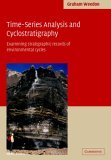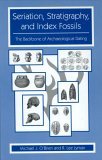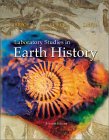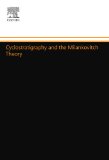|
Unlocking the Stratigraphical Record: Advances in
Modern Stratigraphy
This book introduces the newest exciting techniques
in stratigraphy--the interpretation of rock units as a sequence of events
in the history of the Earth. It describes new tools such as lithostratigraphy,
biostratigraphy and event stratigraphy and then interprets those events
in terms of their "reasonableness" as a whole (the study of
facies and their biological remains). |
|
Stratigraphic Systems: Origin and Application
The statigraphic record represents the history
of processes and events that occurred at the surface of the earth. Presently,
there are no textbooks on the market that integrate physical, chemical,
and biological processes to predict stratigraphic patterns. Visher's authoritative
Stratigraphic Systems fills this niche. It outlines the principle stratigraphic
concepts for exploration of hydrocarvon accumulations, with more than
700 illustrations. Can be used as a primary textbook for an undergraduate
course in stratigraphy and sedimentation. |

|
The Sedimentary Record of Sea-level Change
This unique textbook describes how past changes in sea-level can be detected through an analysis of the sedimentary record. In particular, it concentrates on the current sequence stratigraphy model. It explains this model from basics and shows how the model can be applied to both siliciclastic and carbonate successions. Designed for undergraduate and graduate courses in sequence stratigraphy, as well as for professional courses within the petroleum industry, this full-colour textbook includes numerous features that will aid tutors and students alike. These include detailed case studies demonstrating the practical applications of sequence stratigraphy and set-aside boxes providing supplementary and background information. Bulleted questions and answers are interspersed throughout the text, encouraging students to test their understanding of the material. The book is supported by a website hosting sample pages from the book, selected illustrations to download, and worked exercises. |

|
Principles of Sedimentology and Stratigraphy
A concise treatment of the fundamental principles of sedimentology and stratigraphy, featuring the important physical, chemical, biological and stratigraphic characteristics of sedimentary rocks. Emphasized are the ways in which the study of sedimentary rocks is used to interpret depositional environments, changes in ancient sea level, and other intriguing aspects of Earth history. Topics include the origin and transport of sedimentary materials; physical properties of sedimentary rocks; composition, classification and diagenesis of sedimentary rocks and principles of stratigraphy and basin analysis. For individuals interested in one text providing comprehensive coverage of both sedimentology and stratigraphy. |
|
Historical Geology, Interpretation and Applications
This laboratory manual covers all the topics
essential to the study of historical geology at the introductory level
and is compatible with most commonly used historical geology textbooks.
The manual teaches fundamental concepts of historical geology by providing
realistic situations to which geologic concepts and data apply. This application
of principles to concrete situations and practical problems reinforces
learning while instilling a strong sense of the purpose for geologic study. |

|
Time-Series Analysis and Cyclostratigraphy: Examining Stratigraphic Records of Environmental Cycles
Increasingly, environmental scientists, palaeoceanographers and geologists are collecting quantitative records of environmental changes (time series) from sediments, ice cores, cave calcite, corals and trees. This book explains how to analyze these records, using straightforward explanations and diagrams rather than formal mathematical derivations. All the main cyclostratigraphic methods are covered, including spectral analysis, cross-spectral analysis, filtering, complex demodulation, and wavelet and singular spectrum analysis. Practical problems of time-series analysis are considered in detail. Recent research into various types of tidal and climatic cycles is summarized. |

|
Seriation, Stratigraphy, and Index Fossils - The Backbone of Archaeological Dating
It is difficult for today's students of archaeology to imagine an era when chronometric dating methods were unavailable. However, even a casual perusal of the large body of literature that arose during the first half of the twentieth century reveals a battery of clever methods used to determine the relative ages of archaeological phenomena, often with considerable precision. Stratigraphic excavation is perhaps the best known of the various relative-dating methods used by prehistorians. Although there are several techniques of using artifacts from superposed strata to measure time, these are rarely if ever differentiated. Rather, common practice is to categorize them under the heading `stratigraphic excavation'. This text distinguishes among the several techniques and argues that stratigraphic excavation tends to result in discontinuous measures of time - a point little appreciated by modern archaeologists. Although not as well known as stratigraphic excavation, two other methods of relative dating have figured important in Americanist archaeology: seriation and the use of index fossils. The latter (like stratigraphic excavation) measures time discontinuously, while the former - in various guises - measures time continuously. Perhaps no other method used in archaeology is as misunderstood as seriation, and the authors provide detailed descriptions and examples of each of its three different techniques. Each method and technique of relative dating is placed in historical perspective, with particular focus on developments in North America, an approach that allows a more complete understanding of the methods described, both in terms of analytical technique and disciplinary history. This text will appeal to all archaeologists, from graduate students to seasoned professionals, who want to learn more about the backbone of archaeological dating. |
|
Laboratory Studies in Earth History
Utilizing actual case studies and field photographs,
this successful lab manual covers the full spectrum of historical geology
sediments, plate tectonics, paleontology, and petrology in flexible, self-contained
units. This manual has been developed for use in both nonmajors and combined
courses in historical geology. The exercises emphasize the principles
and methods by which geologists discover the origins and changing nature
of our planet. |
|
Cyclostratigraphy and the Milankovitch Theory
Cyclostratigraphy is concerned primarily with measuring geological time and the time units used in this approach are sedimentary cycles. Milankovitch cycles mark time intervals of tens of thousands to several millions of years. Such cycles are the result of variations in the Earth's position in relation to the Sun and these in turn determine the climatic variations. The Milankovitch theory was resurrected in the 1960's when evidence from Pleistocene deep sea sediments linked orbital variations and climate. This monograph discusses sedimentary cycles and their use in measuring geologic time. There is considerable effort made to clarify the term "sedimentary cycle", in particular, the two opposing concepts of cyclic stratification and event stratification. The recognition of sedimentary cycles and of Milankovitch cycles specifically, is considered and care is taken with the question of relating sediment thickness to time. Several examples from the Carboniferous to the Cretaceous are given to show how cyclostratigraphy can be applied to current geological problems. This volume should be of interest to geologists involved with stratigraphical analysis and basin analysis. |




















